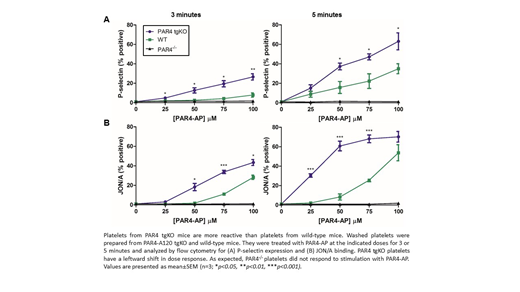PAR4 is a protease-activated receptor with major roles in both platelet aggregation and platelet procoagulant function, contributing to both hemostasis and thrombosis in vivo. It is a major target for anti-thrombotic agents in current development. There are notable differences in the amino acid sequences between human (hu) PAR4 and mouse (mu) PAR4 in domains associated with the mechanisms of receptor action. These include the second transmembrane domain, which has a Valine at position 120 in muPAR4 while it is Alanine or Threonine in huPAR4 (Edelstein, Nature Med 2014). Other differences include 4 non-conservative amino acid changes in extracellular loop 2 and a major non-conservative change (mu = Cysteine, hu = Glutamine) in helix 8 in the cytosolic carboxy terminal (Ramachandran, Mol Pharm 2017).
We generated a unique set of mice which enable us to compare for the first time the potential differences in platelet activation between huPAR4 and muPAR4 in the platelet context, rather than in heterologous cells. We generated and characterized 5 independent lines of mice transgenic for human PAR4, using an approach with a large genomic clone which we have implemented successfully in the past. Each of these huPAR4 transgenic lines has been bred to the mouse PAR4 knockout mice generated by Coughlin and colleagues (generously provided by S. Kunapuli, Temple University). The mice are referred to as PAR4 tgKO mice; 3 express the hu Thr120 allele and 2 the Ala120 allele. The level of huPAR4 expression in the tgKO platelets is equivalent to that of muPAR4 in wild-type mouse platelets.
Washed platelets from wild-type mice, PAR4 tgKO mice, and muPAR4 KO mice were stimulated with a range of concentrations of PAR4 activating peptide (PAR4-AP, AYPGKF) and the activation of αIIbβ3 and expression of P-selectin on the surface were determined with flow cytometry. As expected, muPAR4 knockout mice showed no response to the treatment, but reacted normally to other agonists. While we observed small differences between the hu Ala120 and Thr120 tgKO mice, consistent with prior reports by Bray, Edelstein and colleagues for human platelets, we observed large and statistically significant differences between all tgKO mouse platelets tested and wild-type mouse platelets.
In summary, all other things being equal (i.e. the same platelet context), human PAR4 is a more potent receptor for platelet activation than mouse PAR4. Studies are in progress to elucidate the contribution of the different functional domains and the roles of heterotrimeric G proteins, calcium and other signaling intermediates.
No relevant conflicts of interest to declare.
Author notes
Asterisk with author names denotes non-ASH members.


This feature is available to Subscribers Only
Sign In or Create an Account Close Modal